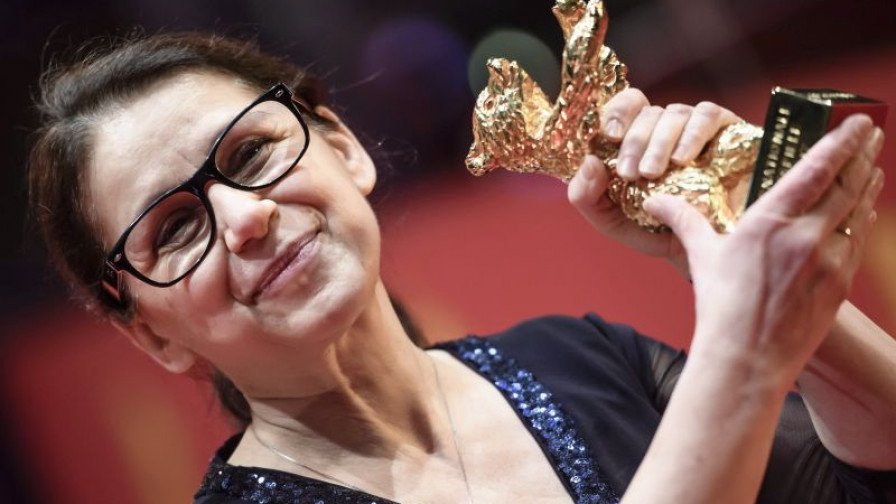Of Bears and Hungarians
When I worked together with Márta Mészáros she would always invite me to her flat in Budapest’s Lágymányosi utca. The name on the doorbell was ‘Jancsó, Mészáros’. I would go upstairs to her home at the end of a corridor, enter the living room, and Márta would seat me in such a way that throughout the course of our conversations and work I would have a clear view of the Bear. The Berlin Golden Bear for her film Adoption. This set the tone for her relationship with younger colleagues in that it was impossible not to respect her and behave one’s best. The Bear commanded respect. This may not have been the deliberate gesture I initially thought it to be; in any case, during our sessions I would always give my every word a lot of thought, conscious that such an important award carried a lot of weight.
In Hungary only women have ever been awarded the Golden Bear. The following awardee of the Berlin festival was Ildikó Enyedi. Upon her return, Bence Fliegauf visited her and had a picture taken with her and the Bear. In the photo, Fliegauf’s own Silver Bear, which he won for Just the Wind (2012), looks on at Enyedi’s standing Golden Bear.
It is remarkable, indeed comforting, that two Hungarian female directors have each been awarded the most treasured Bear for sensitive films that focused on women and the female perspective. The fact that the Golden Bear went to these two directors, and that the Silver Bear went to Fliegauf for Just the Wind and to Béla Tarr for The Turin Horse (2011), says a lot about the Berlinale awards.

Márta Mészáros (Photo: Gábor Valuska)
The festival was and still is clearly fond of experimental, socially sensitive works. Mészáros’s film Adoption (1975) is about a single, childless woman with a disappointing history of relationships who gets an accidental visit from a man living in a foster home, and their fates intertwine. It was as powerful a female perspective as it was unorthodox and bold. It was bold for presenting the 1970s Hungarian society as it was, without making any illusions. The Hungarian film-industry powers failed to understand why this quiet film made it into the 1975 Berlin festival programme. The same bold themes also characterised István Szabó’s two award-winning works, Confidence (1980) and Sweet Emma, Dear Böbe (1992). Made after the collapse of communism, the latter is the most intimate, poetic and low-budget film in Szabó’s rich oeuvre. It too deals with female fates, that of retrained Russian-language teachers, who were the losers of the change in political system and who since have trouble finding their bearings in the new world. Two other films by Mészáros, Nine Months (1976) and Diary for My Lovers (1987), were also invited to the festival.
Twenty-five years after its premiere, the most unorthodox and yet probably best-known Hungarian film, Béla Tarr’s Sátántangó (1994), was screened again in Berlin. Sátántangó’s original Berlin premiere is one of the most important events in Hungarian film history. Susan Sontag remembers, ‘devastating, enthralling for every minute of its seven hours. I’d be glad to see it every year for the rest of my life.’ For Béla Tarr, Berlin brought success: Damnation (1988) had previously premiered there and The Turin Horse had received an award there. Sátántangó is the kind of film that could never have made its debut anywhere else but in a festival that is open to experimenting.

Ildikó Enyedi, Golden Bear (Photo: MTI / EPA)
After the collapse of communism, a few other haplessly forgotten films made it to the festival as well. One such film was Gyula Maár’s Whoops (1993); Temptations (2002), a powerfully atmospheric film by Zoltán Kamondi; and Every Sunday (1997), whose director, Sándor Simó, is best known as being a professor at the University of Film and Drama in Budapest. The ‘Simó class’ included Szabolcs Hajdu, whose Bibliothèque Pascal (2010) made it to Berlin in 2010, and Ferenc Török’s black-and-white film 1945 (2017) saw its premiere in the Panorama section. The latter tells the story of when some Jews, returning to their village to bury their dead, cause turmoil in the life of the villagers. Their slow passage across the village to the cemetery is merciless confrontation. The reason why the film, which deals with conscience and historical and private sins, did not get enough attention when it came out in 2017 was because Enyedi’s On Body and Soul was premiered the same year. The charmingly bizarre love story of two co-workers of an abattoir who share the same dream in which they are deer, as well as its subtle humour and style which melds brutality with intimate imagery, won the Berlin jury over.
One of the important and difficult tasks of producers (the films mentioned here by Bence Fliegauf and Ildikó Enyedi were produced by András Muhi and Mónika Mécs) is to reach out to the right places and, for experimenting Hungarian artists, Berlin is the ideal place to present their work. In the past decades the paths of many Hungarian directors, including animation filmmakers, has led to Berlin. Ferenc Cakó premiered his film Stones (2001), and Hungary’s latest awardee, Flóra Buda, received a Teddy for her film Entropia (2019). For that reason, hoping that within the next seventy years or so Hungarian films will make it to Berlin is perhaps more than just wishful thinking.
